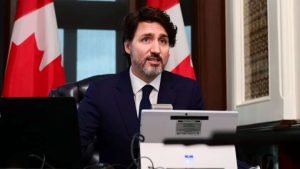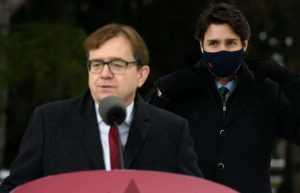Trudeau pledges to slash greenhouse gas emissions by at least 40% by 2030

At an international climate summit convened by U.S. President Joe Biden, Prime Minister Justin Trudeau pledged today that Canada would aggressively curb greenhouse gas emissions over the next decade.
Trudeau unveils new net-zero emissions plan to meet climate change targets
Trudeau said Canada will reduce emissions by 40 to 45 per cent below 2005 levels by 2030 — which would cut total emissions much more than the target first pitched by the former Conservative government and agreed to by former environment minister Catherine McKenna at the Paris climate talks in 2015.
Canada has long maintained it would slash emissions by 30 per cent by 2030. In real terms, that would mean lowering GHG emissions from 732 megatonnes to 513 megatonnes.
Speaking at the summit, Trudeau said Canada is “now on track to blow past our old target.” With today’s more ambitious commitment, Canada is forecasting emissions will drop to at least 439 megatonnes by the end of this decade.
Trudeau said countries around the world must heed the advice of climate scientists and do more to prevent catastrophic increases in global temperatures.
“Our priority continues to be battling COVID-19. We rely on science to save lives and develop vaccines but we must also listen to climate science, which tells us we’re facing an existential threat,” Trudeau said.
He conceded it may be tough for Canada, a major energy producer, to cut emissions so deeply, but he said all countries must rise to the challenge.
“Only bold climate policies lead to bold results,” he said, listing off some of the government’s green-friendly policies such as investments in public transit and clean energy, a ban on single-use plastics and a promise to plant two billion trees.
“We will continually strengthen our plan and take even more action.”
A recent report from Environment and Climate Change Canada concluded Canada’s emissions are headed in the wrong direction.
Canada produced 730 megatonnes of carbon dioxide emissions in 2019, an increase of one megatonne — or 0.2 per cent — over 2018.
The government department found emissions are down just 1.1 per cent compared to that 2005 baseline of 732 megatonnes, but the report suggests Canada is making progress.
The Liberal government did not release a new plan today to explain how it intends to get to that 40 per cent reduction.
At the same meeting, the Biden administration vowed to cut U.S. emissions by 50 to 52 per cent below 2005 levels by 2030 — doubling former president Barack Obama’s pledge for the same time period.
“This is the decade we must make decisions that will avoid the worst consequences of the climate crisis,” Biden said.
The U.S. emissions cuts are expected to come from power plants, automobiles and other sectors across the economy, but the White House did not set individual targets for those industries.
New target both ‘ambitious’ and ‘attainable’: minister
Jonathan Wilkinson, Canada’s environment minister, said Thursday the new target is meant to be both “ambitious” and “attainable.”
The focus on a range of 40 to 45 per cent — as opposed to a specific number — is a reflection of the “uncertainty” that goes into modelling long-term emissions trends.
When the Liberals released an updated climate change plan last December, they estimated that the combination of existing and new measures — including a sizeable increase in the national price on carbon after 2022 — would reduce Canada’s greenhouse gas emissions by 31 per cent below 2005 levels by 2030.

With further investments announced in this week’s budget, the Trudeau government projected that Canada could now achieve a 36 per cent reduction. Finance Minister Chrystia Freeland committed billions of dollars in new spending to help private sector companies — including those in emissions-intensive industries like steel and concrete — develop and adopt cleaner technology.
Getting to 40 per cent or more will require further actions, but Wilkinson defended the decision to set another new target now.
“I think Canadians would say, ‘OK, you demonstrated an ability to actually provide a plan to get a long way, but there’s nine years to go before 2030 and we know from a science perspective we need to do more,’ ” Wilkinson said in an interview with CBC News before Trudeau’s announcement.
Advisers reviewing economic sectors
“And I don’t think Canadians would say, ‘Well, just stop. Thirty-six is it.’ They would say, ‘OK, you don’t necessarily know exactly how you’re going to get there for that final small piece, but we expect you and future governments are going to stretch. You are going to have ambition, you are actually going to make investments next year and the year after and the year after that, to ensure that Canada is doing its part.’ ”
Wilkinson said he has spoken to the co-chairs of the government’s new net-zero advisory panel and he will be asking them to review the Canadian economy, sector by sector, to determine where additional reductions can be made.
He identified buildings as one area where he believes megatonnes can be cut.
“We believe that there are opportunities to make further gains in a number of different sectors. And so we do believe that that range from 40 to 45 is attainable,” Wilkinson said. “I will tell you, the farther out you go up that range, the harder it becomes. But we do believe that it’s attainable.”
The energy sector alone — including combustion at power plants, oil and gas extraction, refining and transportation driven by fossil fuels — accounts for 81 per cent of Canada’s total emissions.
Speaking to reporters after the announcement, Wilkinson said Canada’s oil and gas sector will look much different in ten years’ time.
While there will be demand for oil for “decades to come,” the transition to electric vehicles will result in an overhaul of the country’s energy mix, he said.
New, more stringent regulations on methane emissions, a stricter clean fuel standard — which will require dramatic reductions in emissions intensity — and a much higher carbon price (it will jump from just $40 a tonne this year to $170 a tonne by 2030) will drive down demand for oil, Wilkinson said, resulting in an emissions cut.
The government is also supporting measures to make natural gas less carbon-intensive, he said.
Asked if these targets go far enough, given that other countries have pledged to reduce emissions on a more aggressive timeline, Heritage Minister Steven Guilbeault said that as a major energy producer, Canada faces challenges that a country like Japan — which has few natural resources — does not.
“Like it or not, we’re a large producer of oil and gas, that’s part of our reality. We have to deal with it, we have to address it,” Guilbeault said in French. “We think 45 per cent is as far as we can go.”
O’Toole slams new emissions reduction pledge
Conservative Leader Erin O’Toole, who recently released a climate plan of his own that levies a price on carbon emissions, said a future government led by him would stick to the lower 30 per cent target.
“We will meet our Paris targets. Period. We will not make up things on the fly. Why did Mr. Trudeau make this up today? Because we launched a plan that is vastly better than his,” O’Toole said. The Conservative plan would impose a levy on fuels like oil, natural gas and propane and return the money through a rewards program scheme. Under the current Liberal plan, the carbon levy is rebated in cash at tax time.
O’Toole said the Liberal government has never actually met any of its past climate targets and is now blindly setting new reduction standards without a plan to achieve them.
“Mr. Trudeau is a prime minister who’s an expert on announcements but he gets zero on delivery. He fails every single time,” he said. “Canadians will start judging Mr. Trudeau, knowing his track record of failing to deliver.”
He said Trudeau is intent on imposing higher and higher taxes while “transitioning Canadians out of their jobs,” referring to Liberal plans to craft a “just transition” for workers who may lose their jobs as a result of the shift to cleaner energy sources over the next decade.








Redes Sociais - Comentários